Building Thermal and Energy Performance of Subtropical Terraced Houses under Future Climate Uncertainty
Abstract
:1. Introduction
1.1. Background
1.2. Literature Review
1.3. Aim of This Study
2. Methodology
2.1. Climate Condition of the Site
2.2. Ambient Warmness Degree
2.3. Indoor Overheating Hours (IOH)
2.4. Sensitivity Analysis
2.5. Building Geometry
3. Result
3.1. Severity of Outdoor Climate
3.2. Sensitivity Coefficients of Various Components under Four Climates
3.3. Thermal Discomfort and Energy Demand
4. Discussions
5. Conclusions
Author Contributions
Funding
Data Availability Statement
Acknowledgments
Conflicts of Interest
References
- Ogunbode, C.A.; Doran, R.; Böhm, G. Exposure to the IPCC Special Report on 1.5 °C Global Warming Is Linked to Perceived Threat and Increased Concern about Climate Change. Clim. Change 2020, 158, 361–375. [Google Scholar] [CrossRef]
- He, B.-J.; Wang, J.; Liu, H.; Ulpiani, G. Localized Synergies between Heat Waves and Urban Heat Islands: Implications on Human Thermal Comfort and Urban Heat Management. Environ. Res. 2021, 193, 110584. [Google Scholar] [CrossRef]
- Can, G.; Şahin, Ü.; Sayılı, U.; Dubé, M.; Kara, B.; Acar, H.C.; İnan, B.; Aksu Sayman, Ö.; Lebel, G.; Bustinza, R.; et al. Excess Mortality in Istanbul during Extreme Heat Waves between 2013 and 2017. Int. J. Environ. Res. Public Health 2019, 16, 4348. [Google Scholar] [CrossRef]
- Caldeira, D.; Dores, H.; Franco, F.; Bravo Baptista, S.; Cabral, S.; Cachulo, M.d.C.; Peixeiro, A.; Rodrigues, R.; Santos, M.; Timóteo, A.T.; et al. Global Warming and Heat Wave Risks for Cardiovascular Diseases: A Position Paper from the Portuguese Society of Cardiology. Rev. Port. Cardiol. 2023, in press. [Google Scholar] [CrossRef]
- Perkins, S.E. A Review on the Scientific Understanding of Heatwaves—Their Measurement, Driving Mechanisms, and Changes at the Global Scale. Atmos. Res. 2015, 164–165, 242–267. [Google Scholar] [CrossRef]
- Santamouris, M. Recent Progress on Urban Overheating and Heat Island Research. Integrated Assessment of the Energy, Environmental, Vulnerability and Health Impact. Synergies with the Global Climate Change. Energy Build. 2020, 207, 109482. [Google Scholar] [CrossRef]
- Xia, D.; Zhong, Z.; Huang, Y.; Zou, Y.; Lou, S.; Zhan, Q.; Guo, J.; Yang, J.; Guo, T. Impact of Coupled Heat and Moisture Transfer on Indoor Comfort and Energy Demand for Residential Buildings in Hot-Humid Regions. Energy Build. 2023, 288, 113029. [Google Scholar] [CrossRef]
- Anderson, G.B.; Bell, M.L. Heat Waves in the United States: Mortality Risk during Heat Waves and Effect Modification by Heat Wave Characteristics in 43 U.S. Communities. Environ. Health Perspect. 2011, 119, 210–218. [Google Scholar] [CrossRef]
- Kumar, A.; Singh, D.P. Heat Stroke-Related Deaths in India: An Analysis of Natural Causes of Deaths, Associated with the Regional Heatwave. J. Therm. Biol. 2021, 95, 102792. [Google Scholar] [CrossRef]
- Jung, C.-C.; Hsia, Y.-F.; Hsu, N.-Y.; Wang, Y.-C.; Su, H.-J. Cumulative Effect of Indoor Temperature on Cardiovascular Disease–Related Emergency Department Visits among Older Adults in Taiwan. Sci. Total Environ. 2020, 731, 138958. [Google Scholar] [CrossRef]
- Cleland, S.E.; Steinhardt, W.; Neas, L.M.; Jason West, J.; Rappold, A.G. Urban Heat Island Impacts on Heat-Related Cardiovascular Morbidity: A Time Series Analysis of Older Adults in US Metropolitan Areas. Environ. Int. 2023, 178, 108005. [Google Scholar] [CrossRef]
- Vandentorren, S.; Bretin, P.; Zeghnoun, A.; Mandereau-Bruno, L.; Croisier, A.; Cochet, C.; Ribéron, J.; Siberan, I.; Declercq, B.; Ledrans, M. August 2003 Heat Wave in France: Risk Factors for Death of Elderly People Living at Home. Eur. J. Public Health 2006, 16, 583–591. [Google Scholar] [CrossRef]
- Ke, X.; Wu, D.; Rice, J.; Kintner-Meyer, M.; Lu, N. Quantifying Impacts of Heat Waves on Power Grid Operation. Appl. Energy 2016, 183, 504–512. [Google Scholar] [CrossRef]
- Santamouris, M.; Cartalis, C.; Synnefa, A.; Kolokotsa, D. On the Impact of Urban Heat Island and Global Warming on the Power Demand and Electricity Consumption of Buildings—A Review. Energy Build. 2015, 98, 119–124. [Google Scholar] [CrossRef]
- Roxon, J.; Ulm, F.-J.; Pellenq, R.J.-M. Urban Heat Island Impact on State Residential Energy Cost and CO2 Emissions in the United States. Urban Clim. 2020, 31, 100546. [Google Scholar] [CrossRef]
- Valois, P.; Talbot, D.; Caron, M.; Carrier, M.-P.; Morin, A.J.S.; Renaud, J.-S.; Jacob, J.; Gosselin, P. Development and Validation of a Behavioural Index for Adaptation to High Summer Temperatures among Urban Dwellers. Int. J. Environ. Res. Public Health 2017, 14, 820. [Google Scholar] [CrossRef]
- Lau, A.K.K.; Salleh, E.; Lim, C.H.; Sulaiman, M.Y. Potential of Shading Devices and Glazing Configurations on Cooling Energy Savings for High-Rise Office Buildings in Hot-Humid Climates: The Case of Malaysia. Int. J. Sustain. Built Environ. 2016, 5, 387–399. [Google Scholar] [CrossRef]
- Gou, Z.; Gamage, W.; Lau, S.S.-Y.; Lau, S.S.-Y. An Investigation of Thermal Comfort and Adaptive Behaviors in Naturally Ventilated Residential Buildings in Tropical Climates: A Pilot Study. Buildings 2018, 8, 5. [Google Scholar] [CrossRef]
- Zhai, Y.; Wang, Y.; Huang, Y.; Meng, X. A Multi-Objective Optimization Methodology for Window Design Considering Energy Consumption, Thermal Environment and Visual Performance. Renew. Energy 2019, 134, 1190–1199. [Google Scholar] [CrossRef]
- Sailor, D.J. Risks of Summertime Extreme Thermal Conditions in Buildings as a Result of Climate Change and Exacerbation of Urban Heat Islands. Build. Environ. 2014, 78, 81–88. [Google Scholar] [CrossRef]
- Baba, F.M.; Ge, H.; Wang, L.; Zmeureanu, R. Assessing and Mitigating Overheating Risk in Existing Canadian School Buildings under Extreme Current and Future Climates. Energy Build. 2023, 279, 112710. [Google Scholar] [CrossRef]
- Baglivo, C.; Congedo, P.M.; Murrone, G.; Lezzi, D. Long-Term Predictive Energy Analysis of a High-Performance Building in a Mediterranean Climate under Climate Change. Energy 2022, 238, 121641. [Google Scholar] [CrossRef]
- Andric, I.; Al-Ghamdi, S.G. Climate Change Implications for Environmental Performance of Residential Building Energy Use: The Case of Qatar. Energy Rep. 2020, 6, 587–592. [Google Scholar] [CrossRef]
- Muñoz González, C.M.; León Rodríguez, A.L.; Suárez Medina, R.; Ruiz Jaramillo, J. Effects of Future Climate Change on the Preservation of Artworks, Thermal Comfort and Energy Consumption in Historic Buildings. Appl. Energy 2020, 276, 115483. [Google Scholar] [CrossRef]
- Ciancio, V.; Salata, F.; Falasca, S.; Curci, G.; Golasi, I.; de Wilde, P. Energy Demands of Buildings in the Framework of Climate Change: An Investigation across Europe. Sustain. Cities Soc. 2020, 60, 102213. [Google Scholar] [CrossRef]
- Pérez-Andreu, V.; Aparicio-Fernández, C.; Martínez-Ibernón, A.; Vivancos, J.-L. Impact of Climate Change on Heating and Cooling Energy Demand in a Residential Building in a Mediterranean Climate. Energy 2018, 165, 63–74. [Google Scholar] [CrossRef]
- Flores-Larsen, S.; Filippín, C.; Barea, G. Impact of Climate Change on Energy Use and Bioclimatic Design of Residential Buildings in the 21st Century in Argentina. Energy Build. 2019, 184, 216–229. [Google Scholar] [CrossRef]
- Velashjerdi Farahani, A.; Jokisalo, J.; Korhonen, N.; Jylhä, K.; Kosonen, R.; Lestinen, S. Performance Assessment of Ventilative and Radiant Cooling Systems in Office Buildings during Extreme Weather Conditions under a Changing Climate. J. Build. Eng. 2022, 57, 104951. [Google Scholar] [CrossRef]
- Zou, Y.; Deng, Y.; Xia, D.; Lou, S.; Yang, X.; Huang, Y.; Guo, J.; Zhong, Z. Comprehensive Analysis on the Energy Resilience Performance of Urban Residential Sector in Hot-Humid Area of China under Climate Change. Sustain. Cities Soc. 2023, 88, 104233. [Google Scholar] [CrossRef]
- Hosseini, M.; Javanroodi, K.; Nik, V.M. High-Resolution Impact Assessment of Climate Change on Building Energy Performance Considering Extreme Weather Events and Microclimate—Investigating Variations in Indoor Thermal Comfort and Degree-Days. Sustain. Cities Soc. 2022, 78, 103634. [Google Scholar] [CrossRef]
- Bell, N.O.; Bilbao, J.I.; Kay, M.; Sproul, A.B. Future Climate Scenarios and Their Impact on Heating, Ventilation and Air-Conditioning System Design and Performance for Commercial Buildings for 2050. Renew. Sustain. Energy Rev. 2022, 162, 112363. [Google Scholar] [CrossRef]
- Jafarpur, P.; Berardi, U. Effects of Climate Changes on Building Energy Demand and Thermal Comfort in Canadian Office Buildings Adopting Different Temperature Setpoints. J. Build. Eng. 2021, 42, 102725. [Google Scholar] [CrossRef]
- Moazami, A.; Nik, V.M.; Carlucci, S.; Geving, S. Impacts of Future Weather Data Typology on Building Energy Performance—Investigating Long-Term Patterns of Climate Change and Extreme Weather Conditions. Appl. Energy 2019, 238, 696–720. [Google Scholar] [CrossRef]
- Sánchez-García, D.; Rubio-Bellido, C.; del Río, J.J.M.; Pérez-Fargallo, A. Towards the Quantification of Energy Demand and Consumption through the Adaptive Comfort Approach in Mixed Mode Office Buildings Considering Climate Change. Energy Build. 2019, 187, 173–185. [Google Scholar] [CrossRef]
- Li, X.; Chambers, J.; Yilmaz, S.; Patel, M.K. A Monte Carlo Building Stock Model of Space Cooling Demand in the Swiss Service Sector under Climate Change. Energy Build. 2021, 233, 110662. [Google Scholar] [CrossRef]
- Ramon, D.; Allacker, K.; De Troyer, F.; Wouters, H.; van Lipzig, N.P.M. Future Heating and Cooling Degree Days for Belgium under a High-End Climate Change Scenario. Energy Build. 2020, 216, 109935. [Google Scholar] [CrossRef]
- Spinoni, J.; Vogt, J.V.; Barbosa, P.; Dosio, A.; McCormick, N.; Bigano, A.; Füssel, H.-M. Changes of Heating and Cooling Degree-Days in Europe from 1981 to 2100. Int. J. Climatol. 2018, 38, e191–e208. [Google Scholar] [CrossRef]
- Zhang, S.; Sun, P.; Sun, E.P. Research on Energy Saving of Small Public Building Envelope System. Energy Rep. 2022, 8, 559–565. [Google Scholar] [CrossRef]
- Moreles, E.; Huelsz, G.; Barrios, G. Hysteresis Effects on the Thermal Performance of Building Envelope PCM-Walls. Build. Simul. 2018, 11, 519–531. [Google Scholar] [CrossRef]
- Alshuraiaan, B. Efficient Utilization of PCM in Building Envelope in a Hot Environment Condition. Int. J. Thermofluids 2022, 16, 100205. [Google Scholar] [CrossRef]
- Wu, D.; Rahim, M.; El Ganaoui, M.; Bennacer, R.; Liu, B. Multilayer Assembly of Phase Change Material and Bio-Based Concrete: A Passive Envelope to Improve the Energy and Hygrothermal Performance of Buildings. Energy Convers. Manag. 2022, 257, 115454. [Google Scholar] [CrossRef]
- Aslani, A.; Hachem-Vermette, C. Energy and Environmental Assessment of High-Performance Building Envelope in Cold Climate. Energy Build. 2022, 260, 111924. [Google Scholar] [CrossRef]
- Tarek, D.; Ahmed, M.M.; Hussein, H.S.; Zeyad, A.M.; Al-Enizi, A.M.; Yousef, A.; Ragab, A. Building Envelope Optimization Using Geopolymer Bricks to Improve the Energy Efficiency of Residential Buildings in Hot Arid Regions. Case Stud. Constr. Mater. 2022, 17, e01657. [Google Scholar] [CrossRef]
- Dora, S.; Barta, R.B.; Mini, K.M. Study on Foam Concrete Incorporated with Expanded Vermiculite/Capric Acid PCM—A Novel Thermal Storage High-Performance Building Material. Constr. Build. Mater. 2023, 392, 131903. [Google Scholar] [CrossRef]
- Mourid, A.; El Alami, M.; Kuznik, F. Experimental Investigation on Thermal Behavior and Reduction of Energy Consumption in a Real Scale Building by Using Phase Change Materials on Its Envelope. Sustain. Cities Soc. 2018, 41, 35–43. [Google Scholar] [CrossRef]
- Al-Yasiri, Q.; Szabó, M. Phase Change Material Coupled Building Envelope for Thermal Comfort and Energy-Saving: Effect of Natural Night Ventilation under Hot Climate. J. Clean. Prod. 2022, 365, 132839. [Google Scholar] [CrossRef]
- Yang, X.; Chen, Z.; Zou, Y.; Wan, F. Improving the Energy Performance and Economic Benefits of Aged Residential Buildings by Retrofitting in Hot–Humid Regions of China. Energies 2023, 16, 4981. [Google Scholar] [CrossRef]
- Yu, H.; Li, C.; Zhang, K.; Tang, Y.; Song, Y.; Wang, M. Preparation and Thermophysical Performance of Diatomite-Based Composite PCM Wallboard for Thermal Energy Storage in Buildings. J. Build. Eng. 2020, 32, 101753. [Google Scholar] [CrossRef]
- Al-Yasiri, Q.; Szabó, M. Energetic and Thermal Comfort Assessment of Phase Change Material Passively Incorporated Building Envelope in Severe Hot Climate: An Experimental Study. Appl. Energy 2022, 314, 118957. [Google Scholar] [CrossRef]
- Zou, Y.; Guo, J.; Xia, D.; Lou, S.; Huang, Y.; Yang, X.; Zhong, Z. Quantitative Analysis and Enhancement on Passive Survivability of Vernacular Houses in the Hot and Humid Region of China. J. Build. Eng. 2023, 71, 106431. [Google Scholar] [CrossRef]
- Mutschler, R.; Rüdisüli, M.; Heer, P.; Eggimann, S. Benchmarking Cooling and Heating Energy Demands Considering Climate Change, Population Growth and Cooling Device Uptake. Appl. Energy 2021, 288, 116636. [Google Scholar] [CrossRef]
- Zheng, W.; Wei, F.; Su, S.; Cai, J.; Wei, J.; Hu, R. Effect of the Envelope Structure on the Indoor Thermal Environment of Low-Energy Residential Building in Humid Subtropical Climate: In Case of Brick–Timber Vernacular Dwelling in China. Environ. Technol. Innov. 2022, 28, 102884. [Google Scholar] [CrossRef]
- Rodriguez-Ubinas, E.; Montero, C.; Porteros, M.; Vega, S.; Navarro, I.; Castillo-Cagigal, M.; Matallanas, E.; Gutiérrez, A. Passive Design Strategies and Performance of Net Energy Plus Houses. Energy Build. 2014, 83, 10–22. [Google Scholar] [CrossRef]
- Sadeghipour Roudsari, M.; Pak, M.; Viola, A. Ladybug: A Parametric Environmental Plugin for Grasshopper to Help Designers Create an Environmentally-Conscious Design. In Proceedings of the BS2013: 13th Conference of International Building Performance Simulation Association, Chambéry, France, 26–28 August 2013. [Google Scholar]
- Sarihi, S.; Mehdizadeh Saradj, F.; Faizi, M. A Critical Review of Façade Retrofit Measures for Minimizing Heating and Cooling Demand in Existing Buildings. Sustain. Cities Soc. 2021, 64, 102525. [Google Scholar] [CrossRef]
- GB 50176-2016; Code for Thermal Design of Civil Building. China Architecture & Building Press: Beijing, China, 2016.
- Meinshausen, M.; Smith, S.J.; Calvin, K.; Daniel, J.S.; Kainuma, M.L.T.; Lamarque, J.-F.; Matsumoto, K.; Montzka, S.A.; Raper, S.C.B.; Riahi, K.; et al. The RCP Greenhouse Gas Concentrations and Their Extensions from 1765 to 2300. Clim. Chang. 2011, 109, 213. [Google Scholar] [CrossRef]
- Hamdy, M.; Carlucci, S.; Hoes, P.-J.; Hensen, J.L.M. The Impact of Climate Change on the Overheating Risk in Dwellings—A Dutch Case Study. Build. Environ. 2017, 122, 307–323. [Google Scholar] [CrossRef]
- Bai, L.; Wang, S. Definition of New Thermal Climate Zones for Building Energy Efficiency Response to the Climate Change during the Past Decades in China. Energy 2019, 170, 709–719. [Google Scholar] [CrossRef]
- Bakken, G.S. Measurement and Application of Operative and Standard Operative Temperatures in Ecology. Am. Zool. 1992, 32, 194–216. [Google Scholar] [CrossRef]
- Zhang, Y. Design Criteria of Built Thermal Environment for Hot Summer & Warm Winter Zone of China. Build. Environ. 2015, 88, 97–105. [Google Scholar] [CrossRef]
- Raja, I.A.; Nicol, J.F.; McCartney, K.J.; Humphreys, M.A. Thermal Comfort: Use of Controls in Naturally Ventilated Buildings. Energy Build. 2001, 33, 235–244. [Google Scholar] [CrossRef]
- Ma, P.; Wang, L.-S.; Guo, N. Maximum Window-to-Wall Ratio of a Thermally Autonomous Building as a Function of Envelope U-Value and Ambient Temperature Amplitude. Appl. Energy 2015, 146, 84–91. [Google Scholar] [CrossRef]
- Albayyaa, H.; Hagare, D.; Saha, S. Energy Conservation in Residential Buildings by Incorporating Passive Solar and Energy Efficiency Design Strategies and Higher Thermal Mass. Energy Build. 2019, 182, 205–213. [Google Scholar] [CrossRef]
- El-Darwish, I.; Gomaa, M. Retrofitting Strategy for Building Envelopes to Achieve Energy Efficiency. Alex. Eng. J. 2017, 56, 579–589. [Google Scholar] [CrossRef]
- Yılmaz, Z. Evaluation of Energy Efficient Design Strategies for Different Climatic Zones: Comparison of Thermal Performance of Buildings in Temperate-Humid and Hot-Dry Climate. Energy Build. 2007, 39, 306–316. [Google Scholar] [CrossRef]
- Cho, H.M.; Yang, S.; Wi, S.; Chang, S.J.; Kim, S. Hygrothermal and Energy Retrofit Planning of Masonry Façade Historic Building Used as Museum and Office: A Cultural Properties Case Study. Energy 2020, 201, 117607. [Google Scholar] [CrossRef]
- Hajare, A.; Elwakil, E. Integration of Life Cycle Cost Analysis and Energy Simulation for Building Energy-Efficient Strategies Assessment. Sustain. Cities Soc. 2020, 61, 102293. [Google Scholar] [CrossRef]
- Sağlam, N.G.; Yılmaz, A.Z.; Becchio, C.; Corgnati, S.P. A Comprehensive Cost-Optimal Approach for Energy Retrofit of Existing Multi-Family Buildings: Application to Apartment Blocks in Turkey. Energy Build. 2017, 150, 224–238. [Google Scholar] [CrossRef]

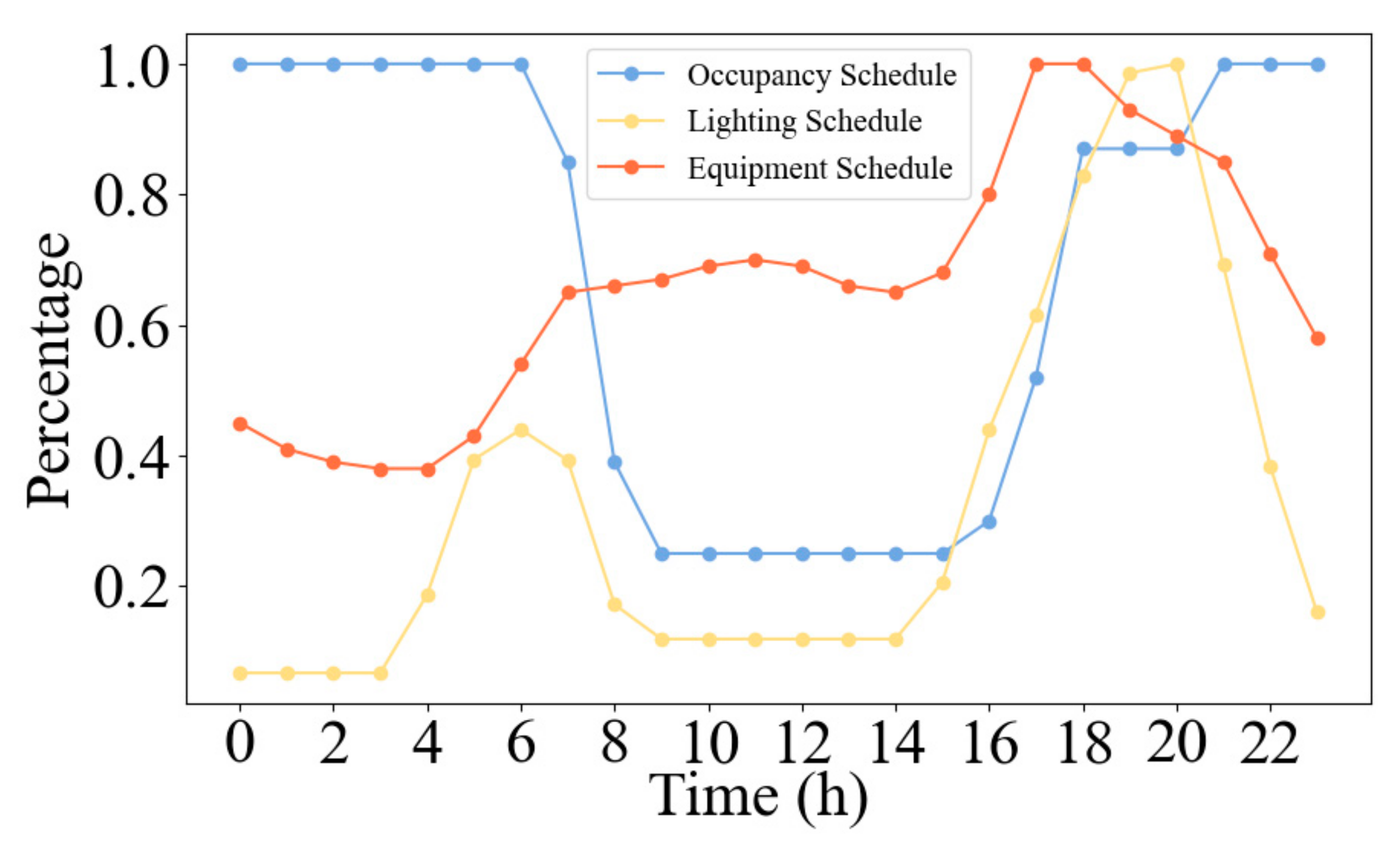
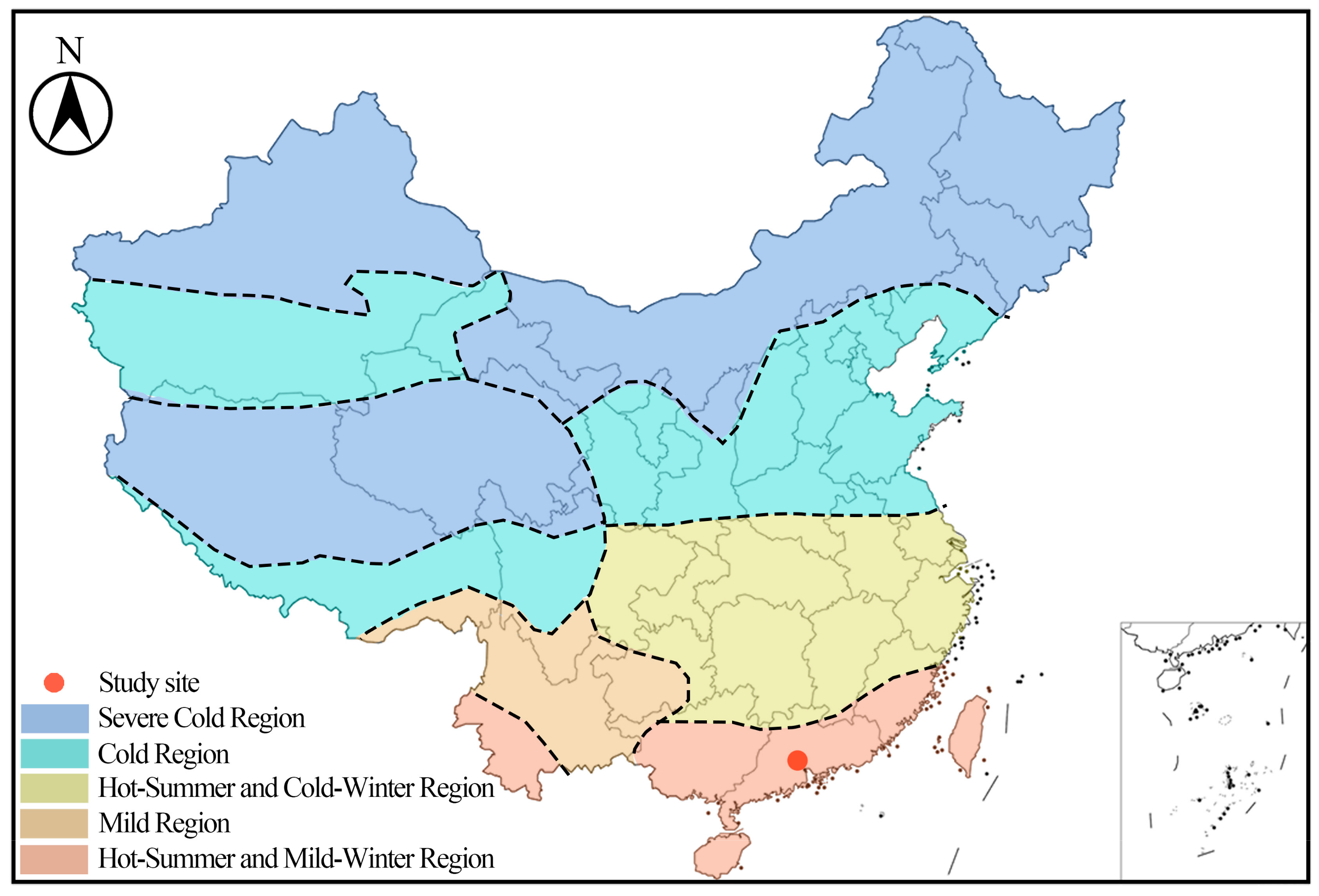




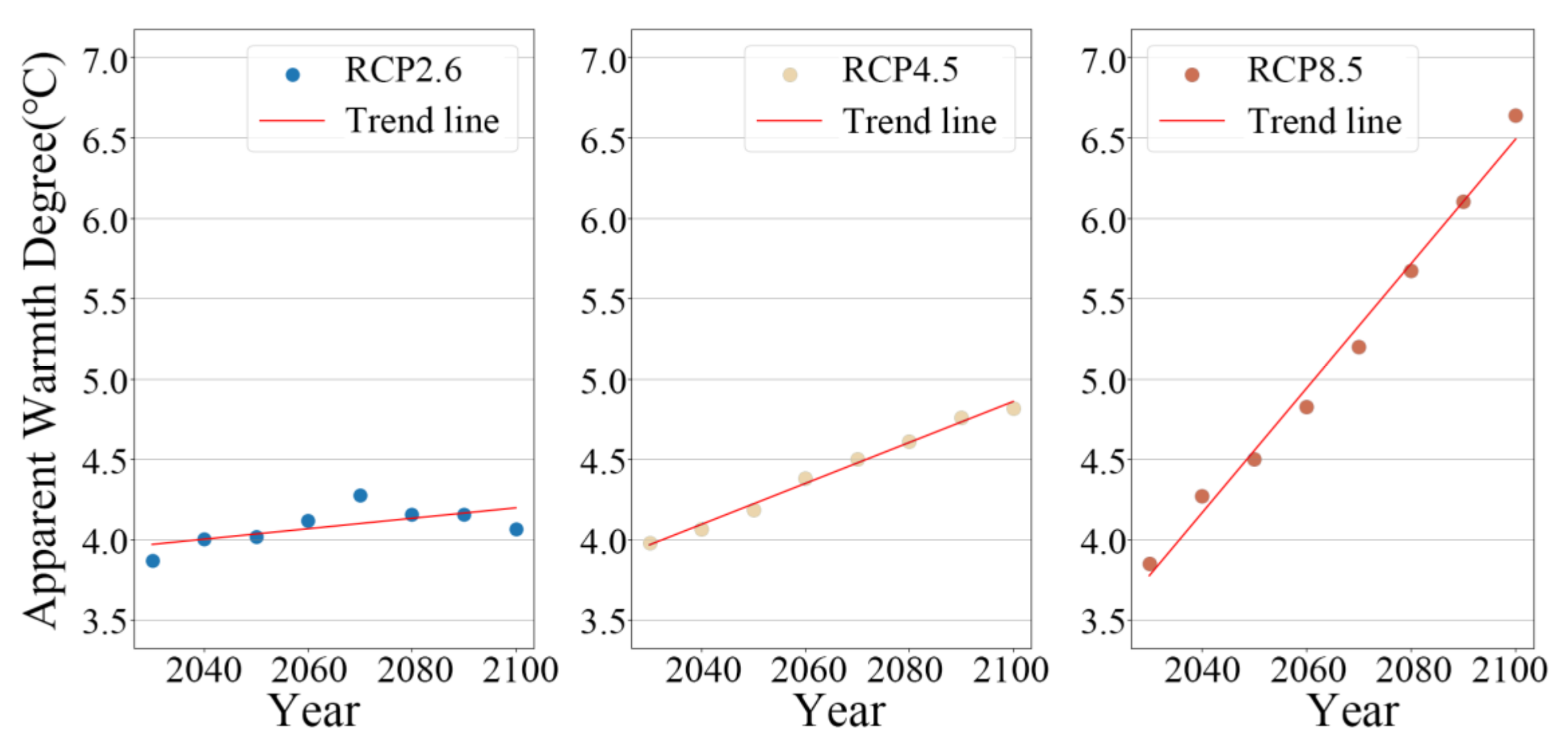


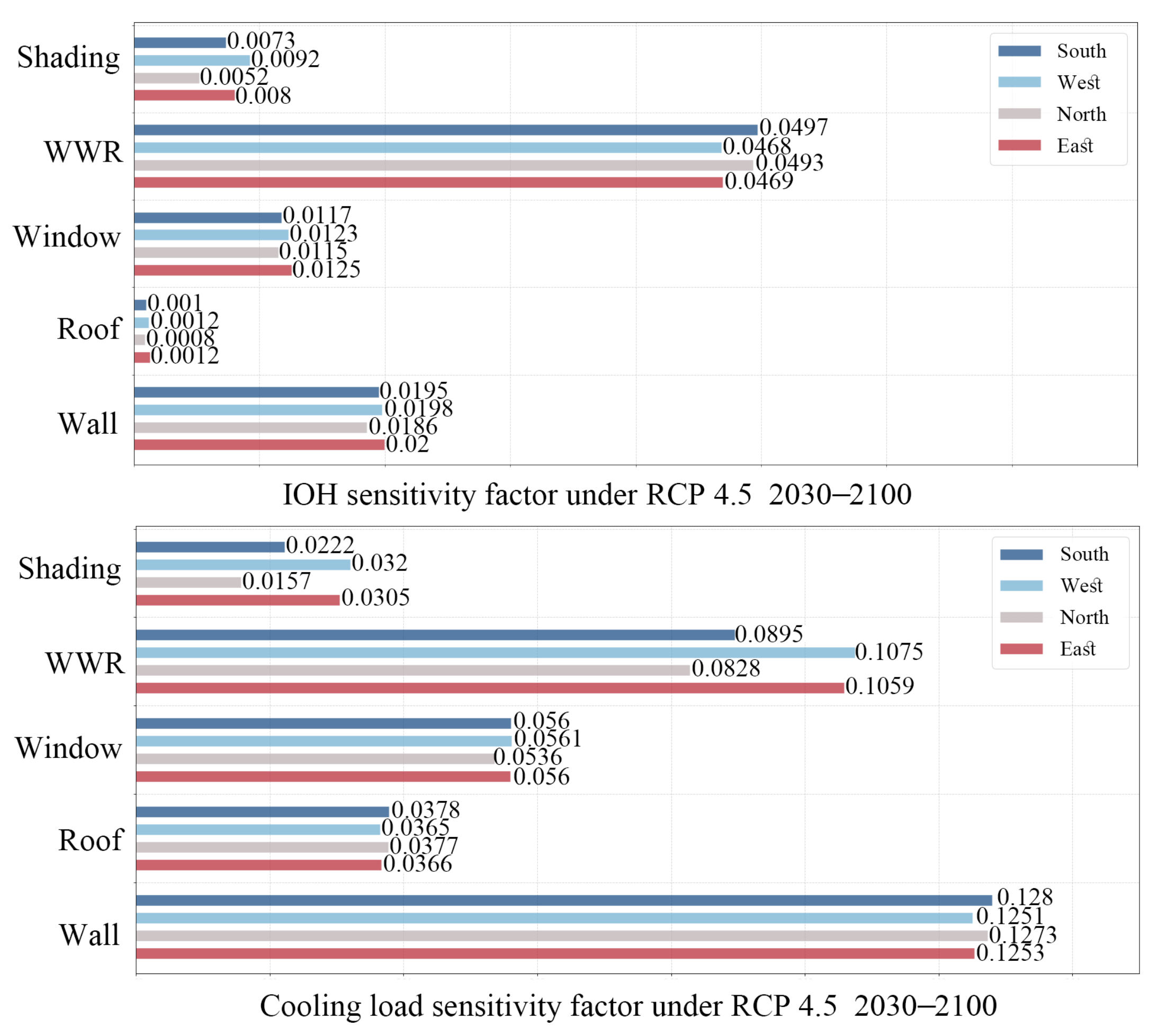
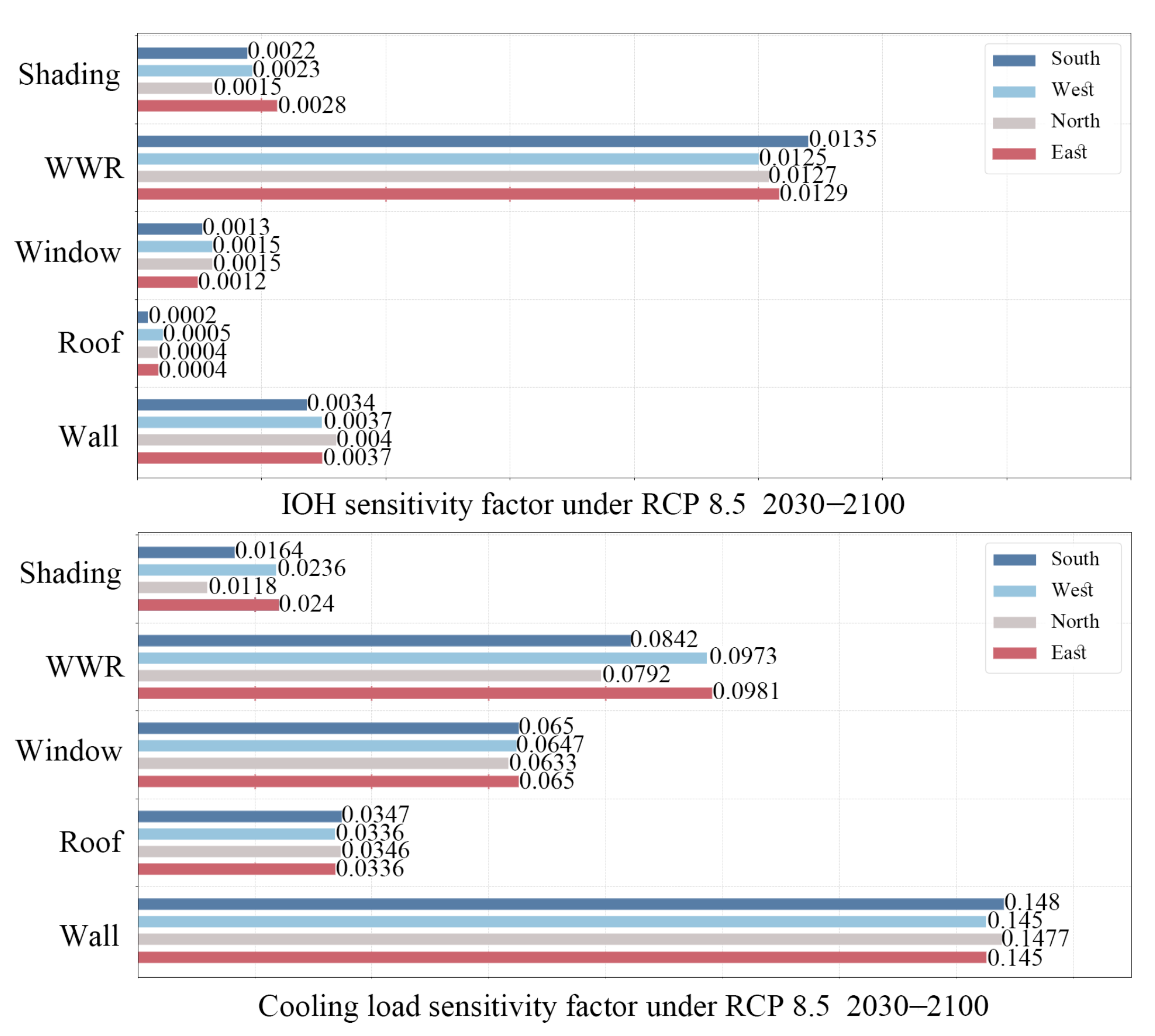

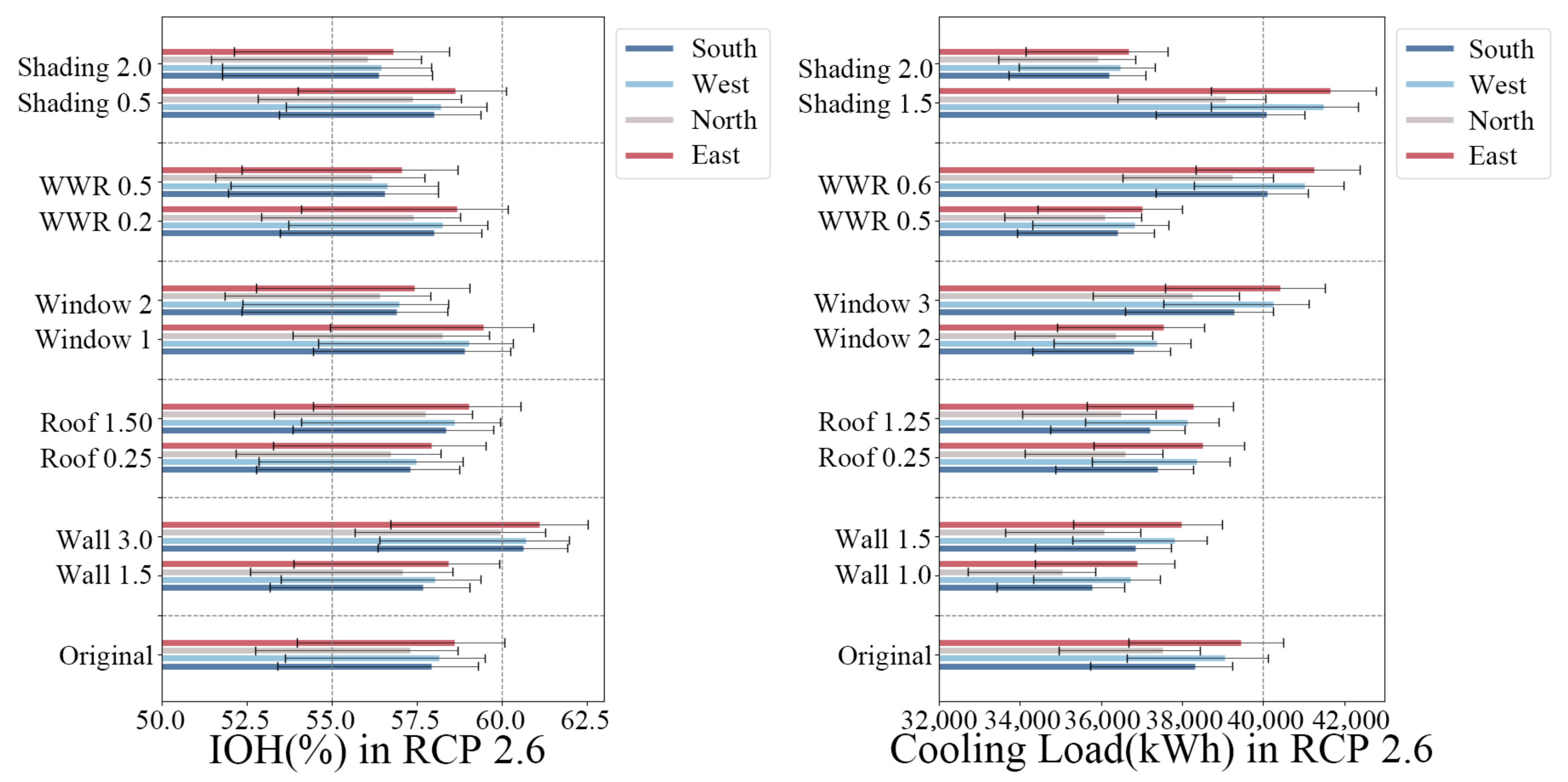




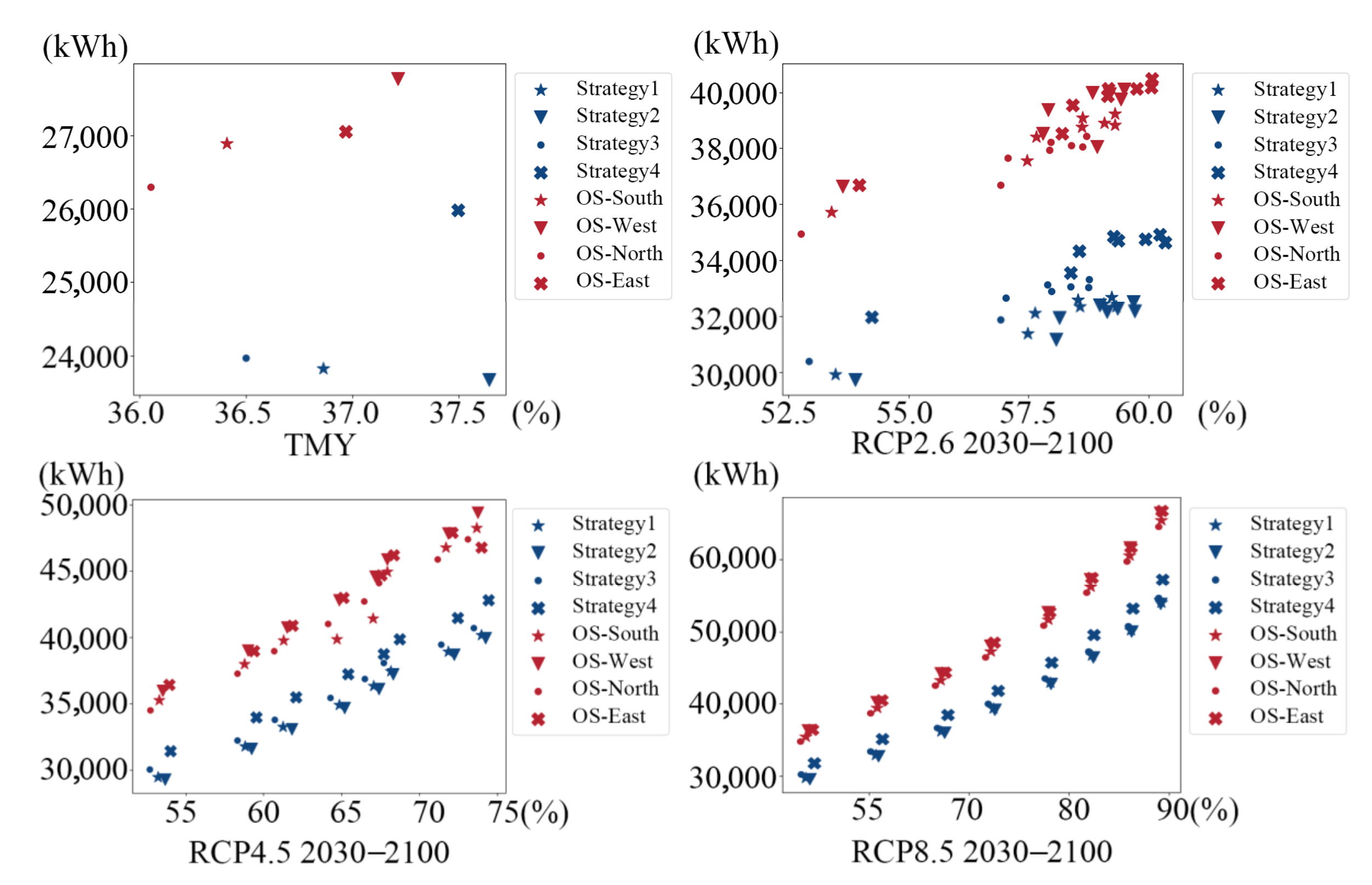
| Simulation Settings | Value |
|---|---|
| Cooling setpoint | 26 °C |
| Equipment Load Per Area | 3.875 W/m2 |
| Infiltration Rate Per Area Facade | 0.0003 m3/s-m2 |
| Lighting Density Per Area | 11.8404 W/m2 |
| Num. Of People Per Area | 0.0283 ppl/m2 |
| Design Strategies | Description | U-Value (W/m2·K) |
|---|---|---|
| Wall | 1—Cement mortar 20 mm 2—Porous brick 3—Exterior cladding | 2.0 |
| Roof | 1—Finish layer 2—Fine stone concrete protective layer 3—Waterproof layer 4—Slope-finding layer 5—Insulation layer 6—1:3.0 Cement mortar 20 mm 7—Reinforced concrete roof panel | 1.0 |
| Window | 1—Glass | 4.0 |
| WWR | 40% | - |
| Shading | - | - |
| South | West | North | East | Original | |||||
|---|---|---|---|---|---|---|---|---|---|
| IOH | Cooling | IOH | Cooling | IOH | Cooling | IOH | Cooling | - | |
| Shading (m) | 0.2 | 0.2 | 0.2 | 0.2 | 0.2 | 0.2 | 0.2 | 0.2 | - |
| WWR (%) | 50 | 50 | 50 | 50 | 50 | 50 | 50 | 50 | 40 |
| Window (W/m2·K) | 2 | 2 | 2 | 2 | 2 | 2 | 2 | 2 | 4 |
| Roof (W/m2·K) | 0.25 | 0.5 | 0.25 | 1.5 | 0.25 | 0.5 | 0.25 | 0.5 | 1 |
| Wall (W/m2·K) | 1.5 | 1 | 1.5 | 1 | 1.5 | 1 | 1.5 | 1 | 2 |
Disclaimer/Publisher’s Note: The statements, opinions and data contained in all publications are solely those of the individual author(s) and contributor(s) and not of MDPI and/or the editor(s). MDPI and/or the editor(s) disclaim responsibility for any injury to people or property resulting from any ideas, methods, instructions or products referred to in the content. |
© 2023 by the authors. Licensee MDPI, Basel, Switzerland. This article is an open access article distributed under the terms and conditions of the Creative Commons Attribution (CC BY) license (https://creativecommons.org/licenses/by/4.0/).
Share and Cite
Xia, D.; Xie, W.; Guo, J.; Zou, Y.; Wu, Z.; Fan, Y. Building Thermal and Energy Performance of Subtropical Terraced Houses under Future Climate Uncertainty. Sustainability 2023, 15, 12464. https://doi.org/10.3390/su151612464
Xia D, Xie W, Guo J, Zou Y, Wu Z, Fan Y. Building Thermal and Energy Performance of Subtropical Terraced Houses under Future Climate Uncertainty. Sustainability. 2023; 15(16):12464. https://doi.org/10.3390/su151612464
Chicago/Turabian StyleXia, Dawei, Weien Xie, Jialiang Guo, Yukai Zou, Zhuotong Wu, and Yini Fan. 2023. "Building Thermal and Energy Performance of Subtropical Terraced Houses under Future Climate Uncertainty" Sustainability 15, no. 16: 12464. https://doi.org/10.3390/su151612464





